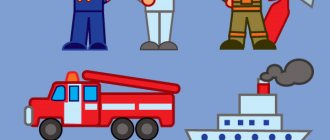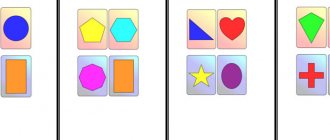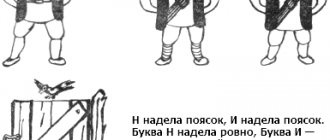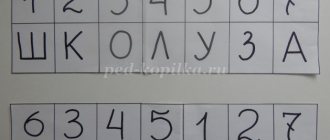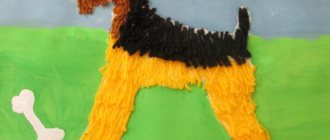How to study pictures of water transport with your child.
The child needs to be shown the cards every day, ideally 3-4 times a day. At the same time, clearly pronounce the name of each water vessel.
Start your lessons with the simplest water equipment: boat, sailboat, yacht, steamship, raft, submarine, cutter, passenger liner, jet ski, inflatable boat. When the child masters them, add new cards to the study.
In the initial lessons, you yourself name what is shown in the picture, and then ask the child to tell you what is on the card.
Then the tasks become more complicated, you add a description to each card. For example, a boat with oars, made of wood, and so on, gradually increasing the amount of information to 10 -12 sentences.
The main rule when conducting any classes with children is to stop before the child gets bored, otherwise he will not want to study the material next time. Even if you showed 2-3 cards and see that the child is distracted by something else, do not insist, put the cards aside until next time.
I personally did this: I didn’t offer the cards to the child myself, but put a stack of cards in the toys and, as if by chance, found them with the words: “Oh, is this something?” Then the child becomes interested and begins to look at the cards himself and tells what is depicted on them, believing that we are playing a game. You can do the same.
Classes using Doman cards perfectly develop a child’s visual memory, attentiveness, and speech. This is a great exercise for the mind.
Summary of the lesson “Water transport”.
Summary of the lesson on the surrounding world “Water transport”.
Goals:
expand ideas about modes of transport, consolidate the names of water modes of transport. To introduce the professions of people who work in water transport.
Progress of the lesson. — Children, what types of transport do you know? (Air, water, land, underground - we show diagrams) - Let's remember the history of the creation of water transport: log - raft - boat - boat - sailing ship - steamship - motor ship - cargo ships - icebreaker - submarine (showing illustrations) - Listen, please, a story from the children's magazine “Sunny Bunny” (according to the text, we put cards with names on the board) “In the Blue Sea”... How many large and small ships and steamers sail along the rivers, seas and oceans! Do you want to know more about them? To begin with, let's agree, like real sea wolves, to call all warships ships, and ships intended for travel and cargo transportation - ships. And it’s also good to know that ships don’t sail on the sea, but walk. Ships on which people travel to different countries, cities, or take boat trips are called passenger ships. The most comfortable and luxurious of them are cruise ships. These are huge ships up to 300 meters long with their own restaurants, shops, playgrounds, swimming pools and cinemas. Vessels that transport bulk cargo - sand, coal, various rocks - are called bulk carriers. They are very stable on water and are made so that their load cannot spill from place to place. Liquid substances help transport tankers. Tankers got their name from special compartments inside the hull – tanks. These compartments can be used to transport petroleum, butter and even fresh water. But the bravest and strongest ships are icebreakers. They courageously make their way through the Arctic ice and rescue their comrades who were captured by the ice from trouble. M. Yurlova Fizminutka: On Monday I swam, and on Tuesday I painted. On Wednesday I took a long time to wash my face, and on Thursday I played football. On Friday I jumped, ran, and danced for a very long time. And on Saturday and Sunday I rested all day. — Children, who do you think works on the ship? Name the professions. *The captain is the main person on the ship. On a warship there is a commander. *navigator - plots the route, indicates the direction of the ship using a sea map, which indicates depths, currents, reefs, underwater rocks) *mechanic - is responsible for all the mechanisms on the ship; in a submarine: for engines, shafts, propellers *boatswain - responsible for all property on the ship, rigging: ropes, chains, anchors. Organizes mooring work - moored, cast off from the pier. *ship's doctor *cook - sea cook *sailors: mechanics, helmsmen, bilge. All professions are important on a ship! — Children, tell me, what new did you learn today, what did you like and remember? (children's answers)
How to make Doman cards yourself:
Print the cards on thick paper or cardboard, 2, 4 or 6 pieces per sheet. To conduct classes using the Doman method, the cards are ready, you can show them to your child and say the name of the picture.
Good luck and new discoveries to your baby!
Educational video for children (toddlers and preschoolers) made according to the Doman method “Prodigy from the cradle” - educational cards, educational pictures on various topics from part 1, part 2 of the Doman method, which can be watched for free here or on our Channel Early Childhood Development on YouTube
Educational cards for children using Glen Doman's method with pictures of water transport
Educational cards for children using Glen Doman's method with pictures of water transport
Educational cards for children using Glen Doman's method with pictures of water transport
Educational cards for children using Glen Doman's method with pictures of water transport
Educational cards for children using Glen Doman's method with pictures of water transport
Educational cards for children using Glen Doman's method with pictures of water transport
Educational cards for children using Glen Doman's method with pictures of water transport
Educational cards for children using Glen Doman's method with pictures of water transport
Educational cards for children using Glen Doman's method with pictures of water transport
Educational cards for children using Glen Doman's method with pictures of water transport
Educational cards for children using Glen Doman's method with pictures of water transport
Educational cards for children using Glen Doman's method with pictures of water transport
Educational cards for children using Glen Doman's method with pictures of water transport
Educational cards for children using Glen Doman's method with pictures of water transport
Educational cards for children using Glen Doman's method with pictures of water transport
Educational cards for children using Glen Doman's method with pictures of water transport
Educational cards for children using Glen Doman's method with pictures of water transport
Educational cards for children using Glen Doman's method with pictures of water transport
Educational cards for children using Glen Doman's method with pictures of water transport
Educational cards for children using Glen Doman's method with pictures of water transport
Educational cards for children using Glen Doman's method with pictures of water transport
Educational cards for children using Glen Doman's method with pictures of water transport
Educational cards for children using Glen Doman's method with pictures of water transport
Educational cards for children using Glen Doman's method with pictures of water transport
Educational cards for children using Glen Doman's method with pictures of water transport
Educational cards for children using Glen Doman's method with pictures of water transport
More of our Doman cards using the “Prodigy from the Diaper” method:
- Alphabet for children using the Doman method
- Set of cards “Letters”
- Cards - Learning to read according to Doman
- Doman Cards - Counting from 1 to 20
- Doman Colors Cards
- Doman Vegetables Cards
- Doman Berries Cards
- Doman Nuts Cards
- Cards Domana Fruits
- Domana Mushroom Cards
- Doman Cards Wild Animals
- Doman cards Pets and birds
- Doman cards Exotic animals
- Doman Birds Cards
- Doman cards Amphibians and reptiles
- Doman Cards Insects
- Doman Butterfly Cards
- Doman Cards Cat Breeds
- Doman Cards Dog Breeds
- Doman cards Underwater world and fish
- Doman Cards Flowers
- Doman Cards Wildflowers-Herbs
- Doman Nature Cards
- Doman cards Natural phenomena
- Doman Cards Toys
- Doman cards Children's creativity
- Doman cards Household appliances
- Cards Domana Furniture
- Domana Cards Tableware
- Doman Clothes Cards
- Doman Cards Shoes
- Doman cards Flat geometric shapes
- Doman cards Volumetric geometric shapes
- Domana Food Cards
- Doman cards Desserts and baked goods
- Doman cards National dishes
- Domana Drinks Cards
- Doman cards On a walk
- Doman Professions Cards
- Doman Cards Transport-1: Ground transport
- Doman Transport-2 cards: Special equipment
- Doman Transport-3 cards: Rail transport
- Doman Transport-4 Cards: Air Transport
- Doman Transport-5 Cards: Water Transport
- Doman cards Sports equipment
- Doman cards musical instruments
- Doman Cards House-Interior
- Doman Cards Home-Personal Items
- Doman Cards House-Household Items
- Doman Math Cards
- Doman Cards Body Parts
- Doman Cards Verbs (actions)
- Doman cards Sights of Russia
- Doman cards World attractions
- Doman Cards Paintings of Great Artists
- Doman Cards Tools
- Doman Cosmos Cards
- Doman's cards "What did man come up with"
- Doman cards “Outstanding Personalities”
- Supercards according to Doman’s method “Wunderkind from the Diaper”, set - “Reading while walking”
- Supercards according to Doman’s method “Wunderkind from the Diaper”, set - “Reading on the street”
- Supercards according to Doman’s method “Wunderkind from the Diaper”, set - “Reading in the Closet”
- Supercards according to Doman’s method “Wunderkind from the Diaper”, set - “Reading in the nursery”
- Supercards according to Doman’s method “Wunderkind from the cradle”, set – “Reading in the kitchen”
- Supercards according to Doman’s method “Wunderkind from the cradle”, set – “Reading at home”
- LARGE set of Doman cards “My first knowledge” for babies from 6 months to 1 year
Target:
formation of ideas about the history of the creation of courts.
Like everything in the world, ships also have their own history. And it began with the appearance of the first raft.
The raft was the easiest to build. It is enough to cut down the trees, trim their branches and tie them in several rows with strong rope. Wood is lighter than water, so it does not sink. People knew about this in ancient times. The raft, of course, did not sink, but it also did not protect the first sailors from strong winds, large waves, thunderstorms and predatory fish. It was difficult to control it, so the current could carry it away in a completely different direction than the traveler expected.
Following the raft, people invented a boat - a shuttle.
She was safer. The canoes were hollowed out of logs. Boats were needed to fish, move across the water in search of hunting, transport goods, and fight.
Boats were made in different ways. In some, a recess for sitting was hollowed out or burned out. Other boats were woven from reeds and reeds. Still others were made of a wooden frame covered with birch bark or bark. The seams of the boats were filled with hot resin. There were boats made of pine planks and with a wooden frame, covered with skins that were soaked in fat. To go out to sea, boats were made deeper. The Indians loved to decorate their boats with designs that terrified the enemy. They were called canoes
and
kayaks.
The large canoe could accommodate up to 11 people.
Boats served not only to fish, transport goods and fight. For some peoples, such as the Vietnamese and Chinese, boats served as a home. They built a shelter made of reeds or bamboo, in which entire families lived. Even now in these countries you can see entire floating settlements on the water. To prevent small children from drowning, they were given a bamboo life jacket.
Unlike a raft, the boat could be steered using oars. The oars were also made of wood.
However, the boat, no matter how large and light it was, could only sail in shallow water. Going on the open sea by boat is dangerous. Then the sailors began to build ships,
small ones at first.
In Russia these ships were called boats.
They made ships from fastened boards. The boards were tarred so that they would not let water through. When there was no wind, the boat was steered using oars. They rowed with oars at the same pace and rhythm. And when the wind blew, they pulled the canvas sail. With a sail, the boat moved quickly through the water. The Egyptians invented sails.
Seafarers set off on long journeys on large sailing ships: caravels, brigantines, frigates
and
schooners.
The sails provided good speed. The disadvantage of sailing ships was their dependence on the wind. During calm (complete absence of wind) such ships did not move.
To remove the dependence of the ship on the wind, they came up with the first machine - like cars, a steam one.
That's why the ship was called
a steamship.
Coal was thrown into the firebox. It burned and heated the water in the boiler. The water began to boil, releasing steam, which moved the wheels of the steamship, which spun, scooping up water with blades, and the steamer floated across the sea. The first steamboat appeared in America.
Later, the steamboat's paddle wheels were replaced by a propeller.
It seemed to screw into the water and move the ship much faster than the paddle wheel. Externally, the propeller is similar to the propeller of a home fan. It has three blades. It is made of durable metal. The size of the propellers depends on the size of the vessel. The larger the ship, the larger they are. Propellers were invented in England and America.
, ships appeared
the engine of which ran not on steam, but on liquid fuel, and then
nuclear-powered ships
with an engine on nuclear fuel.
The first submarine had a wooden hull covered with oiled leather. In it, 12 rowers sat under water for several hours, and its hull almost did not let water through.
Questions and tasks
● What was the first ship? What were his shortcomings?
● Why did people make boats? What were they called? How were they made? What were the names of the Indian boats? How were they different?
● What were the names of the first ships in Rus'? What did they use to move around?
● Which engine was invented first? What was inconvenient about the ship?
● What modern ships do you know?
● Look at the proposed pictures depicting ancient and modern ships. Compare them and tell us about the differences.

